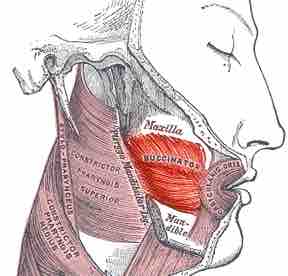The human face is composed of numerous muscles that control fine movement to produce facial expressions. Unlike other muscles, these muscles originate on the bone or fascia of the face and attach directly onto the skin, allowing it to be manipulated. The facial muscles can be split into three groups: orbital, nasal and oral.

Schematic of head and neck muscles.
Locations of facial muscles noted.
Orbital Group
Orbicularis Oculi – A thin muscle that surrounds the eye socket.
- Attachments – Originates from the skull around the eye socket and attaches to ligaments found in the eyelid.
- Actions – Closes the eyelid.
Corrugator Supercilii - A small muscle located superiorly to the orbicularis oculi.
- Attachments - Originates from the bone below the eyebrow and attaches to the skin directly above.
- Actions - Draws the eyebrows together.
Nasal Group
The nasal group of muscles are associated with movements of the nose and surrounding skin.
Nasalis - The largest of the nasal muscles. It is split into two sections: alar and transverse.
- Attachments – Originates from the upper jaw. The alar section attaches to the cartilage of the nose and the transverse section to an aponeurosis covering the bridge of the nose.
- Actions: The transverse section closes the nostrils and the alar part opens them.
Procerus – The most superior of all facial muscles.
- Attachments - Originates from the nasal bone attaching to the skin of the forehead.
- Actions – Pulls the eyebrows down.
Oral Group
Muscles of the oral group play key roles in respiration, communication, eating, and drinking. The lips in particular are controlled by numerous small muscles.
Orbicularis Oris - Muscle fibers that enclose the opening to the oral cavity.
- Attachments – Originates from the upper jaw and muscles of the cheek and attaches to the lips.
- Action: Purses the lips.
Buccinator - This muscle is located between the upper and lower jaws in the cheek, deep to the other muscles of the face.
- Attachments - It originates from upper and lower jaw and attaches to the lips and orbicularis oris.
- Actions - The buccinator pulls the cheek inwards.

Location of the buccinator muscle
Highlighted in orange, the buccinator is associated with the cheeks directly lateral to the mouth
Other Muscles of the Mouth
The levator labii superioris alaeque nasi is the muscle of the upper lip. It acts to lift the upper lift and dilates nostril, producing a snarling expression.
The levator anguli oris (caninus) inserts at the corners of the mouth at an angle, and is associated with other muscles including the zygomaticus, triangularis, and orbicularis oris. When innervated, this muscle contracts to lift the corners of the mouth, producing part of the expression of a smile.
The depressor anguli oris (triangularis) is also associated with the corners of the mouth. Located opposite to the levator anguli oris, it pulls the corners of the mouth downward, producing a frown.
The levator labii superioris is a broad muscle responsible for elevation of the upper lip. This muscle originates at the side of the nose and has several insertion points on either side of the nose, extending down to the lip, and inserting at both lateral and frontal portions of the upper lip.
The depressor labii inferioris is an analogous muscle that lowers the bottom lip.
The zygomatic muscle, associated with the cheeks, is divided into two parts: the major and the minor. The zygomaticus major draws the mouth upward and outward to generate a smile. The zygomaticus minor inserts into the outer part of the upper lip, not the angle of the mouth as with the major. When innervated, contraction of this muscle draws the lip backward, upward, and outward and is associated with facial expressions conveying sadness.
The mentalis, associated with the tip of the chin, is a paired muscle. Sometimes referred to as the pouting muscle, contraction of the mentalis causes the lower lip to be pushed upwards and wrinkles the chin.
The risorius muscle is lateral to the orbicularis oris and inserts into the angle of the mouth. When innervated, the risorius pulls the mouth back mimicking a smile, but does not affect the skin around the smile As a result, this facial expression is often interpreted as insincere.